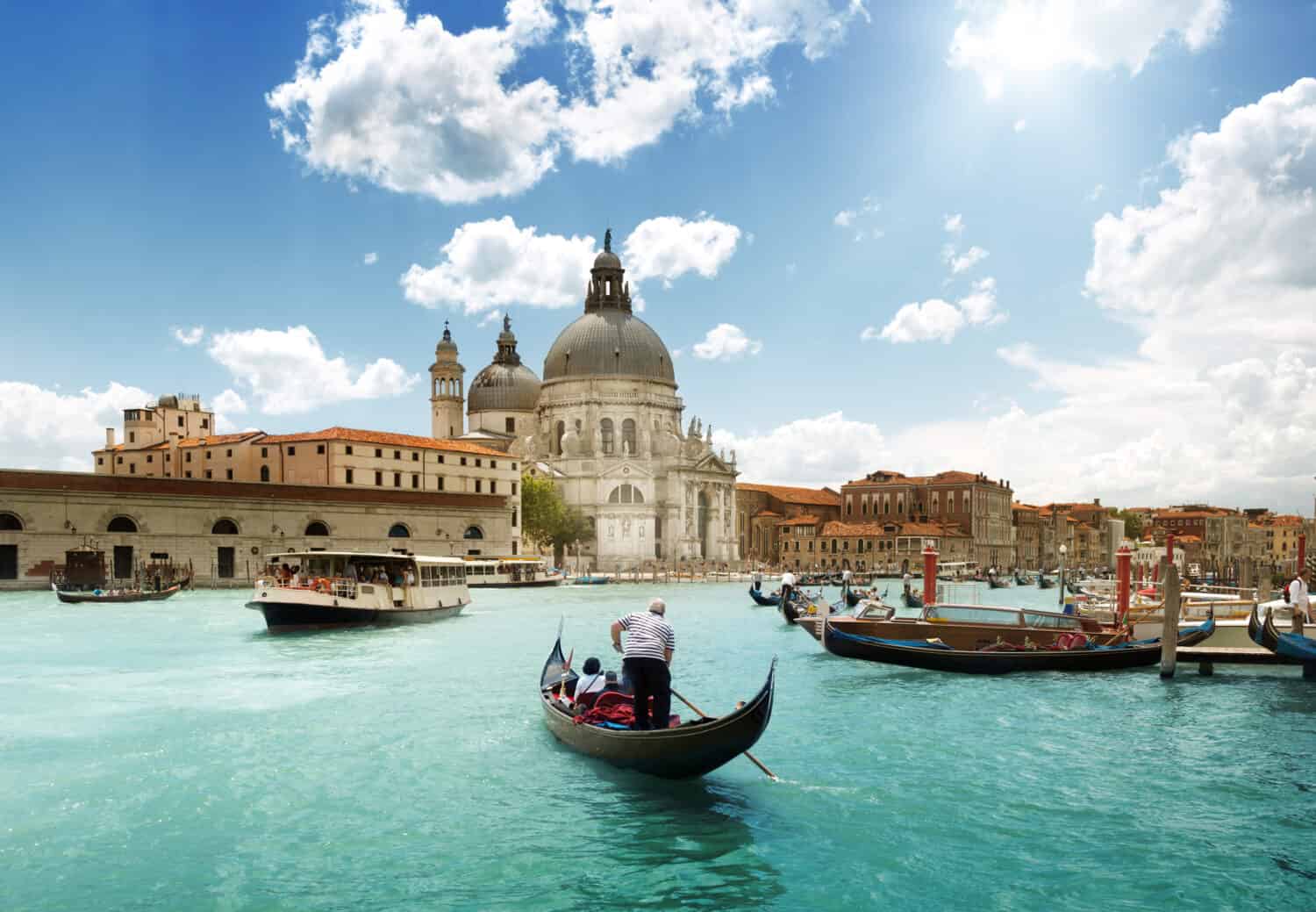Venice, the Italian city built on water, is a city that captivates the imagination with its odd combination of surreal and stable features. Surreal due to the dreamlike nature of travel the city employs. In fact, it’s often referred to as “La Serenissima,” meaning “The Most Serene.” This nickname harkens back to the time of city-states and is a reference to the Republic of Venice (697 CE to 1797 CE). Lasting for 1,100 years, the long-standing history of stability and prosperity of La Serenissima continues in its modern form as “The Most Serene” of cities in Italy.
So, it’s been quite stable, so far. And all of this is thanks to its iconic canals. Here, we dive into the various depths of Venice’s canals, as well as the depths of their significance to the city and the challenges threatening its stability, from the hands of people and vicissitudes of nature alike.
Why Are Venice’s Canals So Important?
Venice Canals’ Historical Significance
The canals served as the veins of a city that was built to be a maritime empire. Originating as a lagoon settlement during the decline of the Roman Empire, Venice grew into a fulcrum of global trade, linking Europe, North Africa, and the Middle East. Its unique architecture was shaped by the diverse cultural influences that converged here, making it a living museum of sorts.
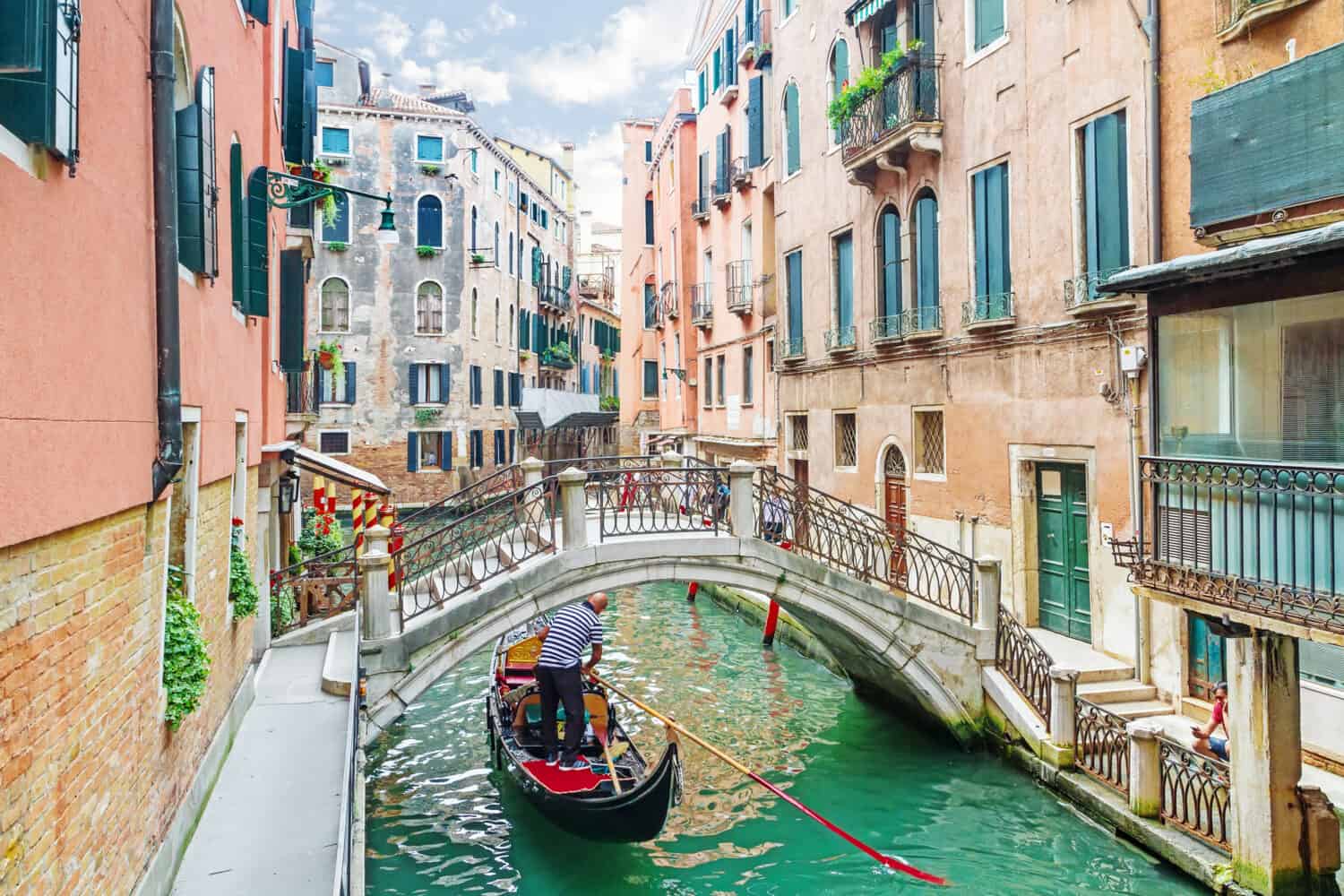
The historic center of La Serenissima is car-free, so rev up your gondola or strap on your hiking shoes to get around.
©g215/Shutterstock.com
Economic Role of Venice Canals in Trade and Tourism
The canals have always been central to Venice’s economy. Historically, they facilitated trade routes to far-flung destinations, making Venice a wealthy city-state. Of course, now there is the Panama Canal. But times change, and today, they are a major tourist attraction. This liquid magnetism doesn’t come without its challenges. 7,000 properties in Venice are listed on platforms like Airbnb, affecting local housing and contributing to a tourism monoculture that the city continues to struggle with.
Venice’s Main Canals and Their Tributaries
The most famous of Venice’s canals is the Grand Canal, a serpentine waterway that curves through the heart of the city. Flanked by historic palazzos, it serves as the main artery for public transport and goods. Like a river in nature, numerous smaller canals branch off from the Grand Canal, creating an intricate maze that’s earned it the title of one of the world’s most beautiful cities.
The Canals’ Influence on Venetian Life
The canals are the lifeblood of Venetian society. They dictate the pace and rhythm of daily life, from the vaporetti (water buses) that ferry residents and tourists alike, to the local grocery stores that have adapted to the influx of tourism. However, the canals also pose environmental challenges, such as rising tides that threaten the city’s future.
In essence, Venice’s canals are a tranquil yet complex network that has shaped the city’s history, economy, and daily life. They’re also a reminder of the challenges that come with such a unique way of life.
The Various Depths of Venice’s Canals
How Depth the Venice Canals Are Varies by Season
The depth of Venice’s canals is subject to the ebb and flow of tides. Normally, the variation is between 0.5 to 1 meter (1.5 to 3.5 feet) every six hours. However, extreme conditions can lead to variations as much as 2 meters (7 feet) or more.
The Shallowest Spots, or Sticking It to the Little Guy
Some of the smaller canals in Venice are particularly shallow, becoming almost impassable at low tide. These canals are often dead ends or too narrow for even the smallest boats to pass.
Reasons and Consequences of Drying Canals in Venice
The shallowness is partly a result of sedimentation and partly due to the city’s unique construction. These shallow canals limit navigation and can pose challenges for local businesses that rely on waterway transport.
The Deepest Areas: The Grand Canal to the Lagoon
It’s called the Grand Canal for a reason. The deepest part within the city, this central waterway retains a depth of up to 5 meters (16 feet). Beyond the city center, the Canale della Giudecca can have depth of up to almost 15 meters (49 feet). On the city’s eastern side, by St. Elena and Isola della Certosa, it’s more than 20 meters (66 feet) deep. In the bay, or lagoon, the waters plunge to around 50 meters (164 feet).
The Canals and the Birth of Venice
The Geographical Uniqueness of Venice’s Lagoon Setting
The Venetian acted as a natural fortress against invasions. When Lombard armies stormed into northern Italy in 568 CE, mainlanders fled to these island sanctuaries, already home to fishermen and salt workers. The lagoon’s intricate waterways thwarted further attacks.
Role of the Canals in Facilitating Trade
The canals played a crucial role in Venice’s rise as a maritime power. They served as the lifelines for trade, allowing the city to engage in commerce with far-flung regions. The canals enabled the easy transport of goods and people, making Venice a hub of international trade.
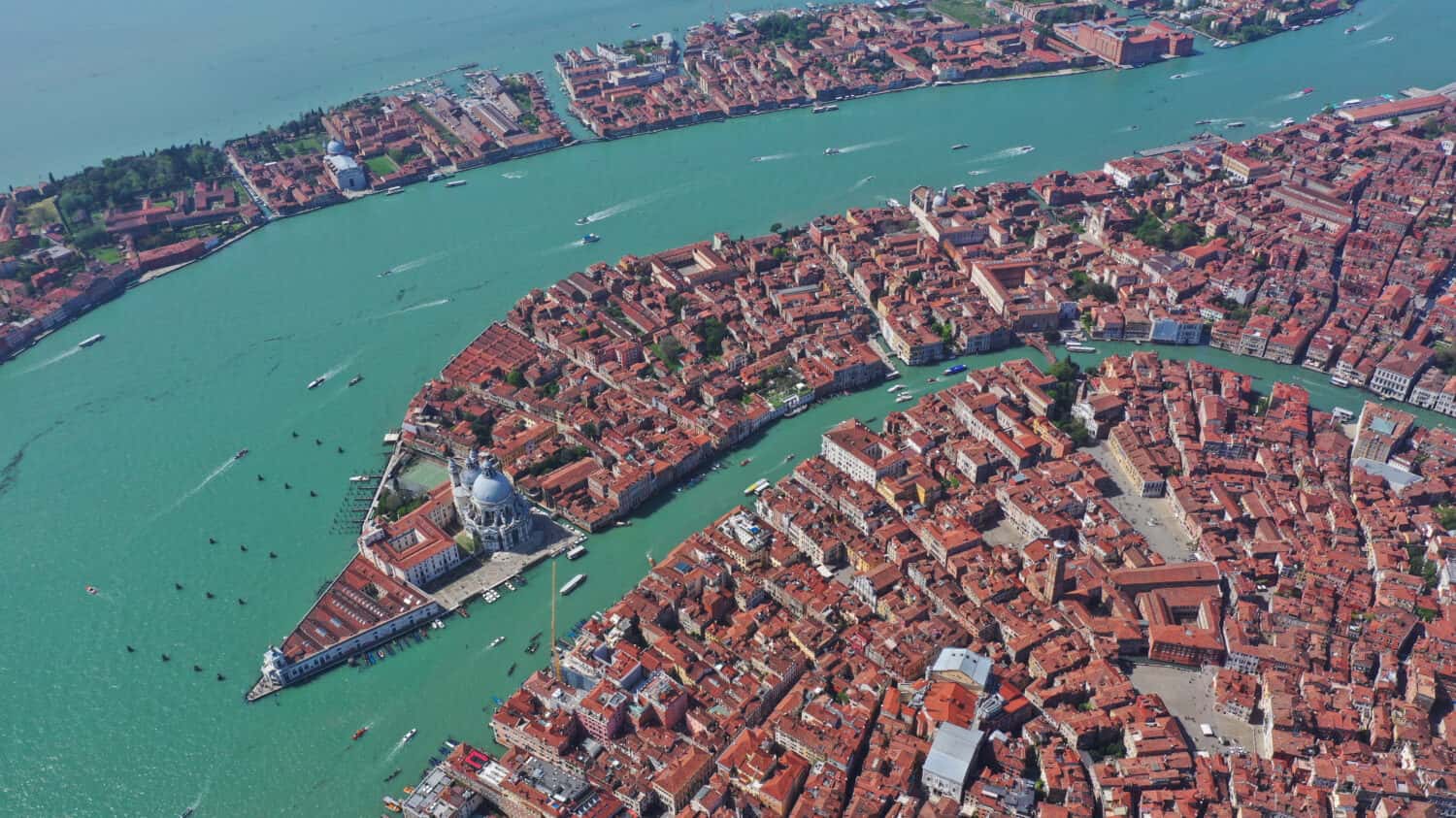
Viewed from above, it’s easy to see that Venice is truly a city built on the water.
©Aerial-motion/Shutterstock.com
Ecology of the Venice’s Canals
Total Length and Number of Canals
Venice is a labyrinth of canals, with the Grand Canal being the most famous. The city has over 150 canals, interlinked by more than 400 bridges. The total length of the canals is approximately 38 miles.
Interaction with the Lagoon and Open Sea
The canals of Venice are an integral part of the larger Venetian Lagoon, which is connected to the Adriatic Sea. The lagoon acts as a buffer, protecting the city from high tides and storms while also serving as a habitat for various marine species.
Biodiversity in the Canals
Fish Species (or Fishes)
The canals are home to a variety of fish species, both native and invasive. The clear waters have recently revealed shoals of tiny fish and scuttling crabs. Cormorants have returned to dive for fish they can now see.
Vegetation and Its Role in the Ecosystem
Multicolored plant life has been observed in the canals, contributing to the ecosystem. Seaweed can be seen in clear waters, a result of the stoppage of motorboat traffic. The vegetation plays a vital role in providing food and shelter to marine life.
Notable Conservation Efforts
Cleanup and Restoration Projects
The clarity of the water has improved dramatically due to reduced boat traffic, but it’s not necessarily due to a lack of pollution. The absence of motorized transport, which normally churns up the muddy canal floor, has contributed to this clarity.
Community-Led Initiatives
Locals have been rediscovering their city and its natural beauty. Signs have been put up to protect duck nests, and there is a growing sentiment among Venetians that nature is taking back possession of the city. This has sparked conversations about finding a balance between the city and tourism, and how to be more organized in the future to protect this fragile ecosystem.
Unusual Phenomena: The Case of the Green Canals in Venice
Mysterious Green Pigmentation
While Italians do celebrate St. Patrick’s Day, it’s not dye-the-river-green celebrated. Italian authorities investigated the cause of the abnormal green color in the waters near Venice’s Rialto Bridge. Unlike previous incidents involving environmental activists coloring monuments, no group has claimed responsibility for this incident. This incident echoes a previous art initiative in 1968, where non-toxic green pigment was spilled in the Grand Canal to raise awareness about water pollution.
Substance Identification and Concerns
Environmental officials discovered that the green color was due to the presence of fluorescein, a non-toxic substance used to test wastewater networks. The origin of the substance is still unknown, and further tests are expected. This incident has raised concerns about eco-vandalism, a trend where activists target landmarks to draw attention to environmental causes.
The Tide of Time: Venice Sinking
Natural Subsidence
Over the many centuries of its storied history, Venice has been sinking due to the settling of the lagoon’s sediment, a natural process of underwater erosion. The city’s foundations are constructed using a system of piles—long lengths of timber that are pushed vertically into the loose mud and clay of the lagoon below. The solid bedrock of the lagoon is far further below the surface than this mud.
Human Activities
We are a thirsty lot, us humans. The indiscriminate pumping of freshwater from a deep aquifer beneath the city has exacerbated the sinking. Additionally, the wakes of boats have damaged many of the city’s buildings, contributing to their sinking foundations.
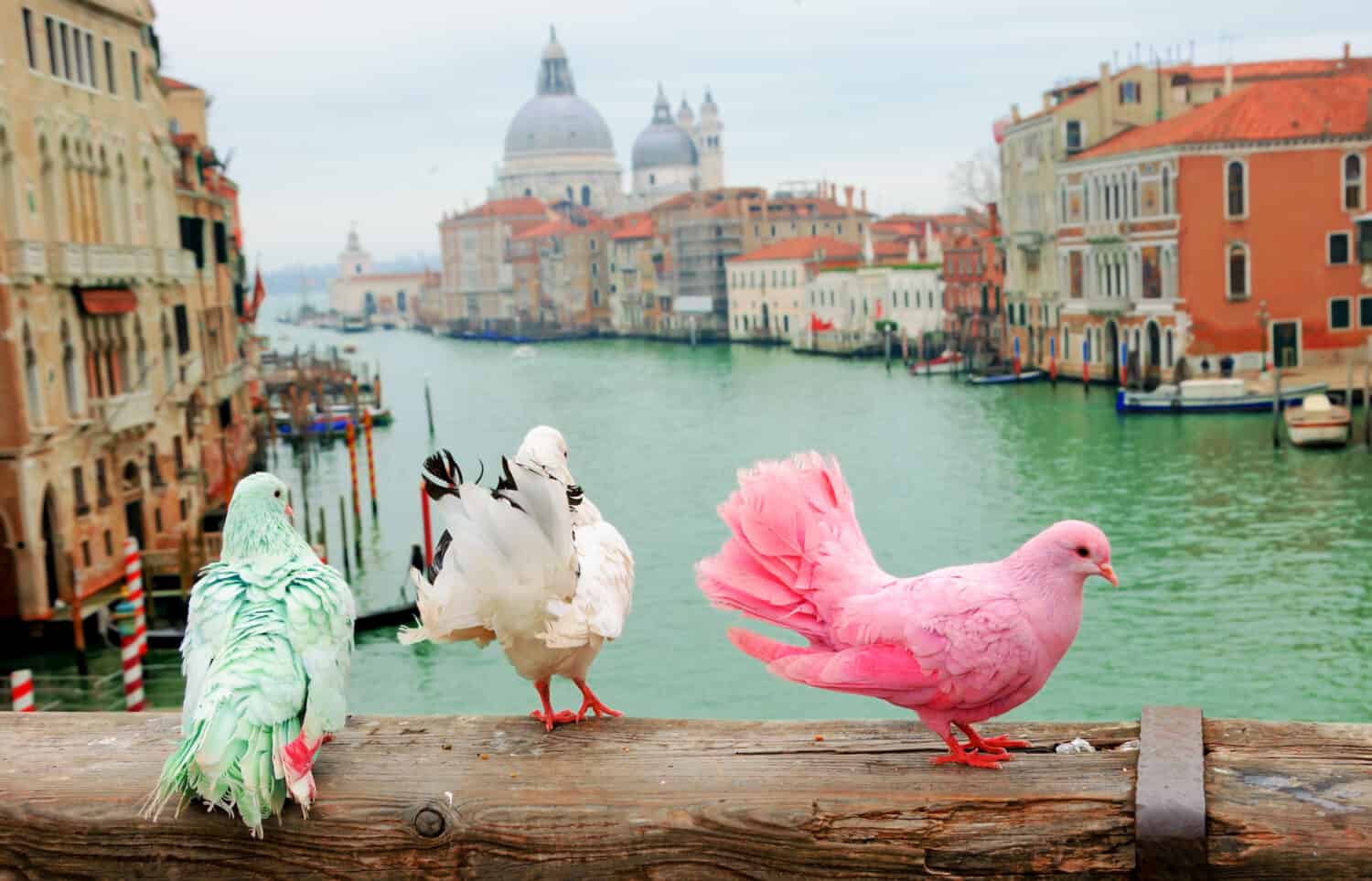
With beauty all around, even the Venetian pigeons are a sight to behold.
©Elena Dijour/Shutterstock.com
Increased Shallowness in Certain Areas
The sinking of Venice has led to increased shallowness in certain areas of the canals. This has been further aggravated by rising sea levels due to climate change, resulting in “acqua alta” or high water, that is higher than normal and occurring more often.
Navigational Challenges for Boats
Boats cannot navigate the canals during the highest tides because they cannot pass under bridges. This has led to more frequent use of elevated wooden walkways, or “passarelle,” as peak tides flow over the city’s sidewalks.
Initiatives to Prevent Venice From Sinking
The MOSE Project
The MOSE Project (Modulo Sperimentale Elettromeccanico) aims to line the bottom of the Venetian lagoon’s three entrances with a series of 79 hollow steel gates that would be raised to hold back the sea in times of “acqua alta.” They essentially function as walls to hold back the sea.
However, the project has been the subject of much debate and its future remains uncertain. From its inception, the project has been riddled with corruption that has skyrocketed project costs. This led to the arrest of 35 people, including Venice’s mayor. Other points of debate include the hydrogeological and environmental issues surrounding the project, as well as the hydraulic efficacy of the project. Moreover, even if the project successfully holds back the rising waters of a warming planet, it’s an outmoded way to approach the problem. Moving forward in this manner would choke off the drainage and exchange channels between the lagoon and the Adriatic Sea, resulting in the stagnation of the former. Critics have pointed to more holistic approaches, like similar projects found in England and Amsterdam.
Sustainable Tourism Efforts: #DETOURISM
Bursting at the liquid seams with tourists, Venice’s infrastructure is under significant strain, worsening the city’s already iffy battle against sinking. The quest for sustainable tourism has become imperative—not just to protect Venice’s iconic canals and historic architecture, but also to uphold local culture and residents’ lives. Venice’s City Council is responding with initiatives like #DETOURISM, a campaign nudging travelers to stray from well-trodden paths and delve into local life.
Organizations like Venezia Autentica are also stepping up. They offer an antidote to mass tourism, steering travelers toward experiences that are not only authentic but also enrich the local community and environment. Their mission aligns with the city’s broader sustainability goals: to spread visitors throughout the year, promote eco-friendly transport, and help keep local Venetians local.
International Recognition: UNESCO’s Warning
World Heritage in Danger
UNESCO has recommended adding Venice and its lagoon to its World Heritage in Danger list due to the serious threats posed by over-tourism, development projects, and climate change. This move highlights the urgent need for a comprehensive and coordinated long-term preservation strategy for the city.
Insufficient Measures to Tackle Rising Venice Canal Problems
Despite efforts such as declaring the waterways around Venice a “national monument” and building sea walls, UNESCO considers these measures currently insufficient and lacking in detail. Italy has been criticized for its inadequate measures to address the issues facing Venice and for its lack of communication with UNESCO.
The Paradox of Dry Canals
Meteorological Factors and Low Tides
Venice has experienced periods of dry canals due to a lack of rain and lingering high-pressure weather systems. This phenomenon, known as “bassa marea,” is caused by a combination of low lunar tides and high air pressure over Italy. While this is typical in winter and usually lasts only a few days, it has been prolonged in recent years due to persistent high-pressure systems.
Broader Environmental Context
The drought situation is not limited to Venice; lakes and rivers across Italy are also experiencing distress. Last year, Italy declared a state of emergency due to a severe drought, and the situation has been worsening since then. However, there is hope for relief as weather forecasts predict precipitation and snow in the Alps will continue on their seasonal trajectory.
Adaptation and Resilience
Despite the dry canals, Venetians have found ways to adapt. Gondola rides are still possible closer to high tide or on the Grand Canal, and other activities such as visiting museums or taking a vaporetto to the outer islands remain viable options.
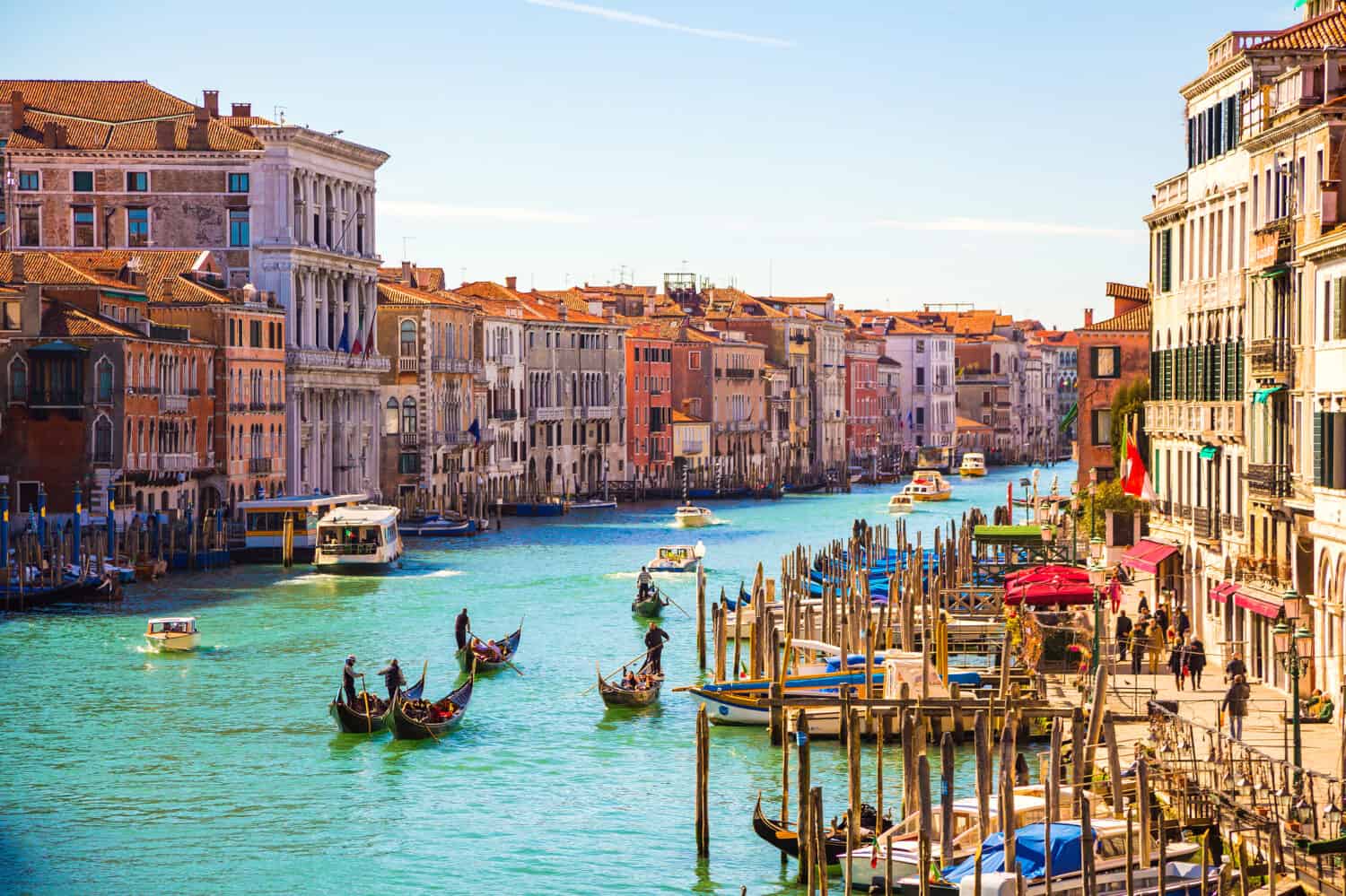
The boat-gondola-walk trifecta makes up Venice’s charming transportation network.
©RAW-films/Shutterstock.com
Life on Venice’s Canals
Importance in Daily Life and Tourism
The vaporetto system serves as the public transport network of Venice, ferrying both locals and tourists through the city’s canals. Water taxis offer a more private and often quicker way to navigate the city. These modes of transport are essential for daily activities, from commuting to work to sightseeing.
How It Adapts to the Varying Depths of the Canals
The vaporetto boats and water taxis are designed to adapt to the varying depths of the canals. During low tides, smaller boats may be used to navigate shallower routes, while high tides may require adjustments in docking locations.
Gondolas: Romance and Reality
Cultural Significance
Gondolas are not just tourist attractions; they are a part of Venetian culture and history. They serve as a primary mode of transport for locals and are integral to the city’s identity.
Modern-Day Gondoliers and Their Challenges
Gondoliers today face challenges such as overcrowding due to tourism and the constant rise and fall of tides, known as “aqua alta.” They have developed innovative solutions like raised walkways and movable barriers to cope with these issues.
Venice Festivals and Events
Venice is a city rich in tradition, a fact made evident by its many festivals and events. Each celebration, from the masquerade balls of Carnival to the solemn religious rituals, gives us a unique experience of the deep cultural history that permeates the evolution of its contemporary society.
Water, Religion, and Art
Let’s begin with the Regatta Storica, a September staple featuring boat races along the Grand Canal. It’s not merely a contest of skill but also a tribute to Venice’s maritime heritage, complete with historic boat designs. Another must-see is Festa della Sensa, a May event that marks Venice’s symbolic “Marriage to the Sea,” with a water procession and cultural festivities.
However, Venice’s festival scene extends far beyond these traditional events. The Carnival, held in February, is a global attraction, featuring an array of masks and festivities. Then there’s La Sensa, yet another homage to Venice’s intimate relationship with the sea. Vogalonga in May or June offers an eco-conscious 30-kilometer (18.64-mile) rowing course, advocating for environmental awareness against motorboat pollution. There’s also the Biennale, a revered art exhibition that happens every two years, drawing art aficionados from across the world. For film enthusiasts, the Venice Film Festival is a marquee event, attracting Hollywood and global cinema’s A-listers.
Religious celebrations like Festa del Redentore in July and Festa della Salute in November are poignant reminders of the city’s gratitude for past relief from plagues and disease. These festivals feature fireworks and solemn rituals, offering both booming spectacle and spiritual quietude.
Art and Architecture Along the Canals
In addition to taking in the many festivals and events of Venice, history and architecture can be fully appreciated during watery transit. The canals are lined with historic buildings like the Doge’s Palace and the Ca’ d’Oro, each with its own unique architecture and history. These buildings serve as a living museum of Venice’s rich past.
Venice is also home to various public art installations that interact with the canals, such as sculptures and murals. These artworks add another layer of beauty and complexity to the city’s already picturesque canals.
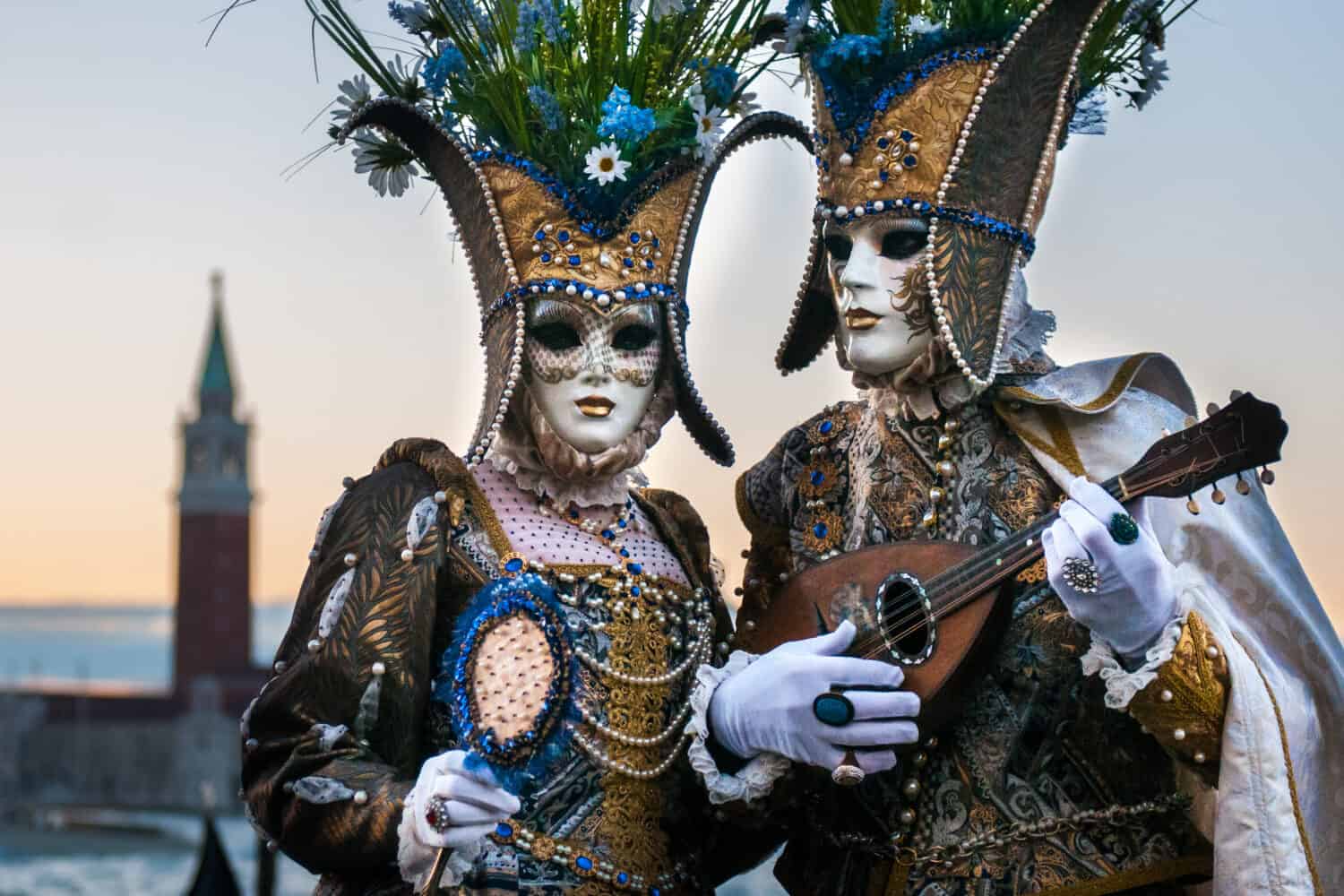
Carnival in Venice is unique for locals’ elaborate costumes and distinct masks.
©Simone Padovani/Shutterstock.com
Cuisines on the Canal: Seafood from the Lagoon
Venice’s culinary scene is as intricate and savorable as its famed canals, providing another point of entry into Italy’s maritime heritage.
Popular Dishes and Their Origins
Perhaps as much as pasta, seafood is a staple of Venetian cuisine. The delectable “Sarde in Saor,” sardines marinated in a sweet and sour sauce, offers a distinct blend of flavors, perfectly balancing sweetness with acidity. Then there’s the “Baccalà Mantecato,” creamed cod that’s been whipped to airy perfection.
But Venice is not only about fish (or fishes, if we’re talking multiple species). The culinary landscape is rife with other local wonders. Think “Risotto al Nero di Seppia,” a risotto imbued with squid ink (yup!), or “Risi e Bisi,” a comforting blend of rice and peas.
You want to also consider trying dishes like “Bigoli in Salsa,” a pasta delicacy made of onion and salt-cured fish. Or the carnivorous treat “Fegato alla Veneziana,” featuring calf liver sautéed with stewed onions. For dessert, try the traditional “Baicoli,” hard biscuits often enjoyed with coffee, or “Fritole,” sweet pastry fritters.
Sips to Savor
Alas, don’t forget the other non-canal liquid that makes Venice great: Venetian wine. The Veneto region offers such sippables as effervescent Prosecco, crisp Soave, and the richly complex Amarone and Valpolicella wines. As with wines in the context of other culinary cultures, these are essential companions to your Venetian seafood feast, each sip enhancing the flavors on your plate.
Conclusion: The Most Serene of Tomorrow Starts Today
La Serenissima and its canals are a living testament to human ingenuity and resilience. Faced with challenges ranging from natural subsidence to the pressures of modern tourism, Venice has continually adapted. Even self-inflicted problems like corruption are now being seriously addressed. The canals themselves have been engineered to accommodate varying water levels, and the people have developed innovative solutions to live in harmony with their aquatic environment. In this sense, the canals symbolize not just Venice’s past, but also its enduring ability to adapt and thrive in a not-so-distant future that makes it harder and harder to hold onto what gives a city and culture its unique depth.
Thank you for reading! Have some feedback for us? Contact the AZ Animals editorial team.

